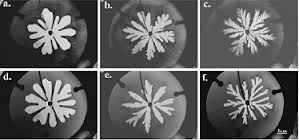Short topics about an expanding droplet experiment, a sort of two-dimensional expanding universe, that, once understood, may shed light on how we think about the forming and growing of primitive relationships across the boundaries of both our observable and our potential universes.
Link to general information on viscous fingering: http://en.wikipedia.org/wiki/Viscous_fingering
Link to video of medium to low viscosity contrast between fluids: https://www.youtube.com/watch?v=WaEG__GxQVo
[Notice if this were an analog of planetary formation in an accretion disk, the high curvature regions are approximately equal at low flow rates (low oscillatory rates) and, possibly, equal-sized planets planets with equal distributions in accretion disks with space and time (See Trappist I https://en.wikipedia.org/wiki/TRAPPIST-1).]
Link to video showing high viscosity contrast across the boundary at high flow rate: https://www.youtube.com/watch?v=gIOxivsQZTM
[Note: When the trough of high curvature initiates relates to the distance in space and time when density distribution is believed to initiate into planet formation. The initiation of a radial sine-wave trough is called solvability of the instability. The troughs, like cgs of massive regions are quite stable and the more dense the region, the more the flow field will bypass high curvature objects.]
Note: What you can see in all of the above videos of this experiment is that there is a little to a lot of splitting of the fingertips (the last case with lots of splitting looks very much like, and is somewhat analogous to, crack and dendritic growth in solids). What you don’t see is the very systematic and resonant way the unstable droplet first vibrates as it creates its own fingers sequentially in time (that is covered in my research).
Graphic Breakdown of Experiment: How Droplet Changes Shape With Time
To access SBK Burns’s published experiment, visit the following link: http://link.springer.com/article/10.1007%2FBF00191691#page-1
INITIATING FLOW DISTRIBUTION CASES: MOST SEEN IN HIGH VISCOSITY STUDIES AT LOW FLOW RATES IN PUBLISHED ARTICLE ABOVE AND THESIS IN UNIVERSITY OF DELAWARE ARCHIVES.

Last on the central row is the unstable distribution of a mildly expanding droplet [The inner fluid considerably less viscous than the outer fluid] Most images of experiments above follow this configuration, but are of higher flow rates.
Center on the bottom line is the unstable distribution of a mildly expanding droplet [The inner fluid is highly viscous, but slightly less viscous than the outer fluid] In this state the central trough [pinched in area) burrows like a membrane through the droplet and appears like cell division. [In this case: the inner flow field is guided by the droplet shape and no longer follows the rules of conduction (in The General Energy Equation]https://unionofoppositesdotcom.files.wordpress.com/2018/02/the-first-cell.pdf

Pingback: Our Oscillatory Universe | The Union of Opposites
Pingback: REALITY | The Union of Opposites
Pingback: Analog | The Union of Opposites
Pingback: September 15, 2018 O: Offset Mode | The Union of Opposites
Pingback: April 17, 2018 Q: Quantum | The Union of Opposites
Pingback: A to Z Blog Challenge | The Union of Opposites
Pingback: April 19, 2018 S: Space | The Union of Opposites
Pingback: April 22, 2018 V: Voyager Satellite/Probe | The Union of Opposites
Pingback: THE STRUCTURE OF CONSCIOUSNESS | The Union of Opposites
Pingback: Why the Observed Acceleration in Universal Expansion? | The Union of Opposites